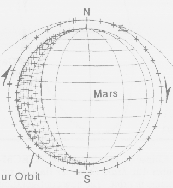
TES News
August/September 1993, Volume 2, No. 2
Thermal Emission Spectrometer Project
Mars Observer Space Flight Facility
Department of Geology, Box 871404
Arizona State University
Tempe, Arizona 85287-1404, U.S.A.

Return to the Red Planet: Mars Observer Orbit Insertion
Thirty years ago, the surface of Mars was known only from the view through
a telescope. In 1965, Mariner 4 became the first spacecraft to see
the planet up close. In 1976, two Vikings landed on Mars and tested
its soil for evidence of life.
Now in 1993, a new era of Mars exploration
is beginning. Mars Observer was launched from the Kennedy Space Center,
Florida, on September 25, 1992. After an 11-month journey, it is the first
U.S. spacecraft to reach the fourth planet since 1976.
Mars Observer will
examine the climate and geology of the Red Planet for at least one martian
year (687 Earth days) from an altitude of about 380 km (236 mi). From this
vantage point, Mars Observer will monitor the climate, polar ice caps,
and surface features as they change with the seasons.
After its arrival on August 24, 1993, the spacecraft will be carefully moved
into a nearly circular, polar orbit over a period of about three months. From
its final mapping orbit, Mars Observer will pass near both the
north and south poles 12 times a day, and it will cross the equator at about
2 PM local time on the day side and 2 AM on the night side of the planet.
The period from August 24, 1993, to mid-November 1993, is called the orbit
insertion phase. The figures shown here (below) illustrate the main orbital
changes that are planned to occur during this time frame. These spacecraft
maneuvers are under the direction of the Mars Observer navigation team
at the Jet Propulsion Laboratory in Pasadena, California. This newsletter
was written prior to Mars orbit insertion on August 24th, thus the
dates that are given for events illustrated in these figures may be
subject to change.
Fig. 1.
Mars Orbit Insertion (MOI) occurs on occurs on
August 24, 1993. This diagram shows the transition from
Mars Observer's interplanetary cruise to the initial
three day capture orbit around Mars. While in this
orbit, Mars Observer takes three days to go around
the planet. By comparison, Mars Observer will circle
Mars once every 2 hours during the mapping phase which begins
in mid-November (see Fig. 5). The three day capture orbit crosses
the daytime martian equator at about 5 PM, whereas the final
mapping orbit in November will cross it around 2 PM. The orbits
of the martian moons, Phobos and Deimos, are also shown here.
The tick marks along the spacecraft orbit path occur every
1 hour.
Fig. 2.
Ellipse Change Maneuver #1 (ECM-1). Around September 4th, Mars
Observer fires its rockets for its first change in orbit. The new
configuration, called the three day drift orbit, is very
similar to the previous three day capture orbit except now the spacecraft
will begin to change its position until it crosses the daytime
martian equator at about 4 PM. The tick marks along the spacecraft
orbit occur every 1 hour.
Fig. 3.
Ellipse Change Maneuver #2 (ECM-2). Around September 15th,
the rockets are fired again to slow Mars Observer so
that it can drop to a lower average altitude (see smaller ellipse).
Now it is in a one day drift orbit, meaning that it circles
the planet once a day. The term "drift" refers to the fact that the
orbit will now slowly change from one that crosses the equator
at 4 PM local time to one that crosses at 2 PM. Recall that crossing
the equator at 2 PM local time is desired for the final mapping
orbit which will begin in November. A minor orbit adjustment,
ECM-3, may occur around October 7th (not illustrated here). Some
of Mars Observer's instruments will obtain limited amounts
of data during the one day drift period illustrated here, however
most data collection will not begin until late November. The tick
marks along the spacecraft orbit occur every 1 hour.
Fig. 4.
Transfer to Low Orbit (TLO-1). Now that Mars Observer
is approximately in the 2 PM equator-crossing position, it must
lower itself toward the desired 380-km altitude. The TLO-1
maneuver will occur around October 17th, and will put Mars
Observer in a lower and less elliptical orbit that will
carry it over each polar region every 4.2 hours. The 4.2
hour orbit is the smaller ellipse in the diagram. The tick marks
along the orbit occur every 1 hour.
Fig. 5.
Transfer to Low Orbit #2 (TLO-2). Around October 28th,
Mars Observer's rockets will again be fired to place it
in the nearly circular polar orbit known as the mapping
orbit. In this figure, the 2 hour mapping orbit
(inner ellipse) is nearly circular, while the previous 4.2 hour
orbit is shown as the larger, more elliptical path. A final
rocket firing (the orbital change maneuver, OCM-1) is planned
for November 8th (not illustrated). This final maneuver will
simply fine-tune the mapping orbit to correct
for any errors. Mapping from this orbit will begin around
November 24, 1993. The tick marks along the orbit path
occur every 10 minutes.
Text and Figures by:
D.E. Melendrez and K.S. Edgett
Original (hardcopy) Typesetting by:
J. Goldblatt
Original Text: August 1993
Hypertext: 21 June 1994

